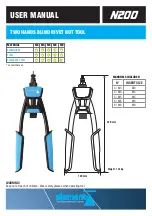
40
Veritas
®
Mk.II Power Sharpening System
On a block plane, the
lever cap also serves as
a cap iron and should
fi t snugly to the blade
across its entire width.
To dress it, scrape the
paint off the last
1
/
4
in. of
the bottom of the lever
cap near the tip and lap
a band about
1
/
8
in. wide
on it (see the drawing on
the left). You should also
fair the curved tip so that
shavings will slide over
it smoothly.
5.
Dress the cap iron:
The cap iron, or "chip
breaker," should be dressed across its width at an
angle that is just slightly less than one that would
make it parallel to the plane blade. This will
ensure that the nose of the cap iron fits tightly to
the plane blade; if there are any gaps, shavings
will inevitably lodge between the cap iron and
the blade, choking the mouth of the plane. This
dressing can easily be done freehand (see the third
photo on the previous page).
As long as the unground tip of the cap iron is
held
1
/
8
in. or more below the level of the stone
being used to shape the tip, you will have the right
geometry to give you a tight fit. After the cap
iron has been dressed and fastened to the blade,
it should meet the blade all across the tip and be
slightly canted away from it toward the arch (see
the photo at the bottom of the previous page).
Sharpening the Blade of
a Plane
Just as you would do with a chisel, the fi rst thing you
do with a plane blade is remove any lacquer or paint
and lap the face of the blade. Lapping can be done on a
medium stone (800x to 1200x) followed by a fi ne stone
(4000x to 8000x). Unlike when lapping a chisel, you do
not have to be concerned about the entire blade being
fl at at the perimeter. Any slight hollowness or belly
in a plane blade is compensated for by the clamping
pressures between the lever cap and the blade. Your
primary concern is just to get a good smooth surface
on the face of the blade near the cutting edge before
turning your attention to the bevel.
After choosing the bevel angle (see the discussion of
specifi c types of planes for recommended angles), I
strongly recommend that you use a honing guide for
the bevel-shaping process. The guide lets you apply
greater pressure while holding the exact angle you
want, and you get better results in less time than with
freehand honing.
As with chisels, I recommend putting the basic bevel
on the blade at 1° less than the micro-bevel. Basic
shaping on an 800x stone and fi nishing on a 4000x to
8000x is suitable.
Choosing a Bevel Angle
Choosing a bevel angle is a nearly limitless discussion
area because of the nearly limitless combination of plane
types, wood types and cutting processes. Many aspects
will be covered under the various plane types detailed
in the rest of this chapter, but the fi rst major division
is between those planes where the blade is used bevel
down (the vast majority, including all bench planes) and
those planes where the blade is bevel up – the block
planes and low-angle special-purpose planes.
Bench Planes
Virtually all bevel-down planes have bed angles of
45° or 50°. In the areas of greater specialization, 45°
bed angles are commonly used for softwoods and 50°
beds for hardwoods. The bed angle is not signifi cant
to the choice of bevel angle in either case. Anything
between 30° and 35° is quite acceptable. If you go
much lower than 30° you encourage blade chatter; if
you go much higher than 35° any wear dulls the blade
much faster, but, more signifi cantly, you could reduce
the relief angle unacceptably, particularly on planes
with a 45° bed.
Bevel-down planes as a group represent an exception
to the general rule that blades should be sharpened
at the lowest angle consistent with edge retention,
because the bevel angle has no bearing on the cutting
angle. A sturdy edge is wanted, and a basic grind angle
of 30° to 35° will give you good blade stability and the
least chatter.
Dressing a Block-Plane
Lever Cap
An unlapped blade (left) and a lapped one (right).
Fair curve for
good chip-breaker
action.
Remove paint.
Lap
1
/
8
-in.
band.
Содержание Mk.II
Страница 6: ...vi Veritas Mk II Power Sharpening System ...
Страница 14: ...8 Veritas Mk II Power Sharpening System ...
Страница 20: ...14 Veritas Mk II Power Sharpening System ...
Страница 33: ...27 Exploded Assemblies Master Parts List 5 3 13 9 7 2 14 24 21 1 6 22 20 19 18 17 16 15 23 4 ...
Страница 36: ...30 Veritas Mk II Power Sharpening System ...
Страница 70: ...64 Veritas Mk II Power Sharpening System ...
















































